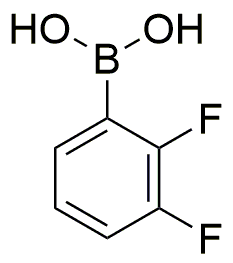2,3-Difluorophenylboronic acid is widely utilized in research focused on:
- Pharmaceutical Development: This compound serves as a crucial building block in the synthesis of various pharmaceuticals, particularly in the development of drugs targeting cancer and other diseases. Its unique properties enhance the efficacy of drug candidates.
- Organic Synthesis: It is employed in Suzuki-Miyaura cross-coupling reactions, allowing chemists to create complex organic molecules with precision. This application is vital in the production of agrochemicals and fine chemicals.
- Material Science: The compound is used in the development of advanced materials, including polymers and nanomaterials, which have applications in electronics and coatings, providing improved durability and functionality.
- Bioconjugation: It plays a significant role in bioconjugation techniques, facilitating the attachment of biomolecules to surfaces or other molecules, which is essential in drug delivery systems and diagnostic applications.
- Research in Fluorinated Compounds: As a fluorinated boronic acid, it is valuable in studies exploring the properties and reactivity of fluorinated compounds, contributing to advancements in medicinal chemistry and materials research.
General Information
Properties
Safety and Regulations
Applications
2,3-Difluorophenylboronic acid is widely utilized in research focused on:
- Pharmaceutical Development: This compound serves as a crucial building block in the synthesis of various pharmaceuticals, particularly in the development of drugs targeting cancer and other diseases. Its unique properties enhance the efficacy of drug candidates.
- Organic Synthesis: It is employed in Suzuki-Miyaura cross-coupling reactions, allowing chemists to create complex organic molecules with precision. This application is vital in the production of agrochemicals and fine chemicals.
- Material Science: The compound is used in the development of advanced materials, including polymers and nanomaterials, which have applications in electronics and coatings, providing improved durability and functionality.
- Bioconjugation: It plays a significant role in bioconjugation techniques, facilitating the attachment of biomolecules to surfaces or other molecules, which is essential in drug delivery systems and diagnostic applications.
- Research in Fluorinated Compounds: As a fluorinated boronic acid, it is valuable in studies exploring the properties and reactivity of fluorinated compounds, contributing to advancements in medicinal chemistry and materials research.
Documents
Safety Data Sheets (SDS)
The SDS provides comprehensive safety information on handling, storage, and disposal of the product.
Product Specification (PS)
The PS provides a comprehensive breakdown of the product’s properties, including chemical composition, physical state, purity, and storage requirements. It also details acceptable quality ranges and the product's intended applications.
Certificates of Analysis (COA)
Search for Certificates of Analysis (COA) by entering the products Lot Number. Lot and Batch Numbers can be found on a product’s label following the words ‘Lot’ or ‘Batch’.
Numéro de catalogue
Numéro de lot/série
Certificates Of Origin (COO)
This COO confirms the country where the product was manufactured, and also details the materials and components used in it and whether it is derived from natural, synthetic, or other specific sources. This certificate may be required for customs, trade, and regulatory compliance.
Numéro de catalogue
Numéro de lot/série
Safety Data Sheets (SDS)
The SDS provides comprehensive safety information on handling, storage, and disposal of the product.
DownloadProduct Specification (PS)
The PS provides a comprehensive breakdown of the product’s properties, including chemical composition, physical state, purity, and storage requirements. It also details acceptable quality ranges and the product's intended applications.
DownloadCertificates of Analysis (COA)
Search for Certificates of Analysis (COA) by entering the products Lot Number. Lot and Batch Numbers can be found on a product’s label following the words ‘Lot’ or ‘Batch’.
Numéro de catalogue
Numéro de lot/série
Certificates Of Origin (COO)
This COO confirms the country where the product was manufactured, and also details the materials and components used in it and whether it is derived from natural, synthetic, or other specific sources. This certificate may be required for customs, trade, and regulatory compliance.


